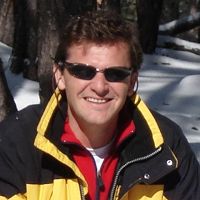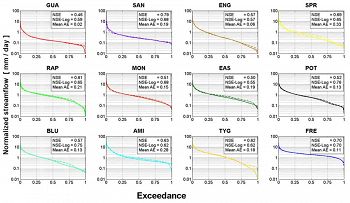hsB-SM
Semi-Distributed Hydrologic Model
Semi-distributed hydrological model called hsB-SM (hillslope storage Boussinesq-Soil Moisture)
Model Category: Conceptual | Numerical
Image: Schematic representation of dominant processes included in hsB-SM.
-
Catalina-Jemez, INVESTIGATOR
Observed (solid line) versus simulated (dashed line) flow duration curves for 12 catchments across a climate gradient (1990-1999). The inset shows the Nash-Sutcliffe efficiency (NSE), the Nash-Sutcliffe efficiency after log-transforming streamflow (NSE-Log) and the mean absolute error between observed and modeled ordinates of the FDC (Mean AE; in mm/d) (Carrillo et al., 2011).
Required model forcing variables are precipitation, air temperature, downward short- and longwave radiation, relative humidity, atmospheric pressure and wind speed. Other required model inputs include time evolution of catchment-wide leaf area index (LAI) and albedo.
References
Carrillo, G., P.A. Troch, M. Sivapalan, T. Wagener and K. Sawicz: Catchment Classification: Hydrological Analysis of Catchment Behavior through Process-based Modeling along a Climate Gradient, HESS, 15, 3411-3430, doi:10.5194/hess-15-3411-2011, 2011.
Troch, P. A., Paniconi, C., and van Loon, E. E.: The hillslope-storage Boussinesq model for subsurface flow and variable source areas along complex hillslopes: 1. Formulation and characteristic response, Water Resour. Res., 39(11), 1316, doi:10.1029/2002WR001728, 2003.
Troch, P. A., Smith, J. A., Wood, E. F., and de Troch F. P.: Hydrologic controls of large floods in a small basin: central Appalachian case study, J. Hydrol., 156, 285-309, 1994.
Observed (solid line) versus simulated (dashed line) flow duration curves for 12 catchments across a climate gradient (1990-1999). The inset shows the Nash-Sutcliffe efficiency (NSE), the Nash-Sutcliffe efficiency after log-transforming streamflow (NSE-Log) and the mean absolute error between observed and modeled ordinates of the FDC (Mean AE; in mm/d) (Carrillo et al., 2011).
Explore Further



